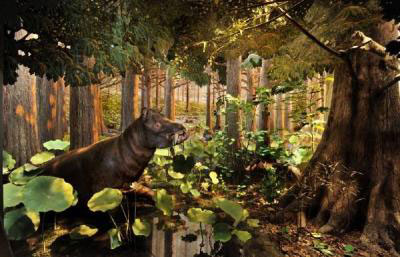Hippo-like Mammals Once Basked in Toasty Arctic

How did cold-blooded alligators and giant tortoises once thrive well above the Arctic Circle?
It turns out the climate in some Arctic locales sometimes never dipped below freezing some 50 million years ago, scientists now reveal.
These new findings could foreshadow the impacts of continuing global warming on arctic plants and animals, researchers added.
Harsh existence
Scientists investigated Ellesmere Island in the High Arctic, which nowadays is one of the coldest, driest environments on Earth, where sparse vegetation and a few mammals eke out life amid tundra, permafrost and ice sheets. Temperatures on the island, which is adjacent to Greenland, range from roughly minus 37 degrees F in winter (minus 38 Celsius) to 48 degrees F (nearly 9 degrees C) in summer. [Check out "The Harshest Environments on Earth"]
"We go up in July each year, which is usually the most pleasant month in the Arctic, but even on a really nice year like this year, we still lost a day to weather, with a helicopter stuck in the snow," researcher Jaelyn Eberle, a vertebrate paleontologist at the University of Colorado at Boulder, told LiveScience. The scientists always have to keep a shotgun with them, she noted, to ward off polar bears.
However, during the early Eocene period about 50 million years ago, Ellesmere Island was probably similar to swampy cypress forests in the southeastern United States today. Fossils collected there in recent decades by various teams revealed a lush landscape, which hosted giant tortoises, aquatic turtles, alligators, large snakes, flying lemurs, tapirs and hippo-like and rhino-like mammals.
Get the world’s most fascinating discoveries delivered straight to your inbox.
Animal teeth hold climate clues
To see what temperatures might have been like back then, Eberle and her colleagues analyzed oxygen isotopes in fossil bones and teeth of mammals, fish and turtles from the island. (Isotopes are atoms of the same element with different numbers of neutrons.)
These animals included a large, hippo-like mammal known as Coryphodon, as well as bowfin fish with long dorsal fins and powerful jaws and aquatic turtles from the Emydidae family, the largest and most diverse family of contemporary pond turtles.
The concentrations of lighter and heavier oxygen isotopes found in these fossils match those found in the water the animals drank. This water came down as rain and snow in air masses that developed in the tropics. If the voyage to the poles was cold for the air masses, they likely shed the heavier oxygen isotopes over time, but if the climate was warmer, they probably kept more of their heavier isotopes. In other words, the warmer the area was, the more heavy oxygen isotopes one could find in fossils.
"By looking at a host of animals with different physiologies, we were better able to pin down warm- and cold-month temperatures," Eberle added.
The team concluded the average temperatures of the warmest month on Ellesmere Island during the early Eocene were from 66 to 68 degrees F (19 to 20 degrees C), while the coldest-month temperature was about 32 to 38 degrees F (0 to 3.5 degrees C).
"Our data gathered from multiple organisms indicate it probably did not get below freezing on Ellesmere Island during the early Eocene, which has some interesting implications," Eberle said.
Implications for future climate change
These new findings imply Eocene alligators could withstand slightly cooler winters than their present-day counterparts. Still, data from captive modern alligators show they can survive short intervals of subfreezing temperatures by submerging themselves in the water.
In contrast, the existence of large land tortoises in the Eocene High Arctic is still somewhat puzzling, Eberle said, since today's large tortoises inhabit places like the Galapagos Islands, where the cold-month average temperature is about 50 degrees F (10 degrees C.)
However, during the late Pleistocene period some 10,000 to 50,000 years ago, when air temperatures were comparable to those today, large land tortoises were found as far north as present-day Pennsylvania and Illinois, Eberle said. This suggests their present range in the Americas does not represent their fullest geographic range as allowed by climate. Factors such as hunting by early Native Americans and the past extent of glaciers may play a role in where giant tortoises thrive today, she explained.
These new findings could serve as omens of the impact of continuing global warming on arctic plants and animals, Eberle said. Temperatures in the Arctic are rising twice as fast as those at mid-latitudes as greenhouse gases build up in Earth's atmosphere, due primarily to human activities like fossil fuel burning and deforestation, according to climate scientists.
"These fossils are really important to our understanding of the Arctic during the height of past global warming and could be the key to a lot of questions we have about current global warming," Eberle said. "We've got to look at these areas as deep-time laboratories that are key to predicting what we're in for in the future."
"This year could be a blip, but this year it hit 80 degrees [F] (26.6 degrees C) there, the warmest I've ever felt it," she added.
When it comes to analyzing fossils from the island to learn more about the past and potentially the future, scientists are concerned over a proposal to mine coal at the ancient fossil site. "Sites like this are unique and extremely valuable resources that are of international importance, and shouldn't be allowed to disappear," Eberle said. "Our concern is that coal-mining activities could damage such sites, and they will be lost forever."
The scientists detailed their findings in the August issue of the journal Earth and Planetary Science Letters.



